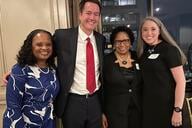You have /5 articles left.
Sign up for a free account or log in.
Two years. That’s how long colleges have to prepare for the enrollment cliff predicted by the Western Interstate Commission on Higher Education. Beginning in 2025, they anticipate that there will be approximately 400,000 fewer traditional-age students graduating from high school and enrolling in universities. With many universities dependent on tuition revenue, this cliff represents a significant disruption for the industry.
As part of my dissertation to understand how institutions are preparing, I visited with chief marketing officers at 15 universities across the Southeast United States to learn more about how they’re approaching this reality, the challenges they see coming and how marketing can play a role in combating this unprecedented challenge.
Four Strategies
A few key strategies emerged that could be significant in helping universities grappling with this challenge.
1. Invest in Branding Efforts
Nearly 75 percent of the participants I visited with had just completed a brand refresh or were undertaking one. The participants explained their branding efforts were more about consistent messages and much deeper than colors and logos. The reason being that if competition is increasing because there are fewer students, what a university can provide for prospective students needs to be easy to understand, and branding helps communicate that. One challenge to this effort was getting the entire campus involved to ensure that faculty and other students were talking about the university in the same way.
“Brand is always important. It’s one of the most important and hardest things to keep going because, in my opinion, a lot of what branding is about is simply being consistent in who you are and what you say you are … and getting the entire campus to understand that.” —Study Participant
2. Collaborate With Enrollment
Almost two-thirds of participants said they had a strong relationship with their partners in enrollment. However, nearly half of participants had to work continuously at building that relationship. Without collaboration with enrollment, resources are wasted because of misalignment on messaging and advertising. To remedy this, participants suggested meeting each week and reviewing the enrollment goals by audience and also reviewing the marketing team’s efforts to support those goals.
“When they establish their recruitment goals each year, they share that information with me … And if you have a good relationship with that department then you can pretty much develop your plans and then you can develop goals and tactics yourself to support them.” —Study Participant
3. Personalize Everything You Can
Every participant talked about their journey involving using more data for personalization. For some that was complex CRMs with lots of automation. For others that was crafting messages by region. The reality is every single participant recognized the value of customizing content and trying to make all communications with prospective students more personal. As this generation expects personalized approaches, the participants saw this as table stakes to remain competitive among other universities.
“We are having to use every tool available to create increasingly tailored and personalized communication … It has to be specific to the student, their interests, their intended academic program, their geographic origin and their academic background. We’ve already been forced to move toward having one on one conversations with 100,000 students at the same time, and I think that’s only going to continue as we near this cliff.” —Study Participant
4. Don’t Forget About Trying New Things
Tik Tok. It’s an example I heard again and again. Participants mentioned the advertising market shifts daily. New platforms pop up. Others fade. Those who are able to best adapt were those who set aside marketing dollars to test new strategies or platforms. It helped them understand the platform, explore potential opportunities quickly and evaluate did new strategies help in achieving their goals.
“There are also some things that we say this is a place we need to invest just to test, so there’s a balance of that. I think it’s good business to use your budget wisely with testing monies.” —Study Participant
Where do we go from here?
With only two years ahead of this cliff, the time to get started is now. As marketing teams, it is easy to see that we can play a part in this work. And we should. Instead of waiting to be asked for help, we can take the lead. Through working on our brand, building collaboration, enhancing personalization and trying new things, we can help our universities prepare. As marketers, we know the key steps to take. While the lift is great, the outcome is critical for our institutions. Let’s get to work.
Carrie Phillips is chief communications and marketing officer at the University of Arkansas at Little Rock. For her dissertation, she looked at how marketing teams and marketing strategies might be employed to help mitigate the enrollment cliff.




